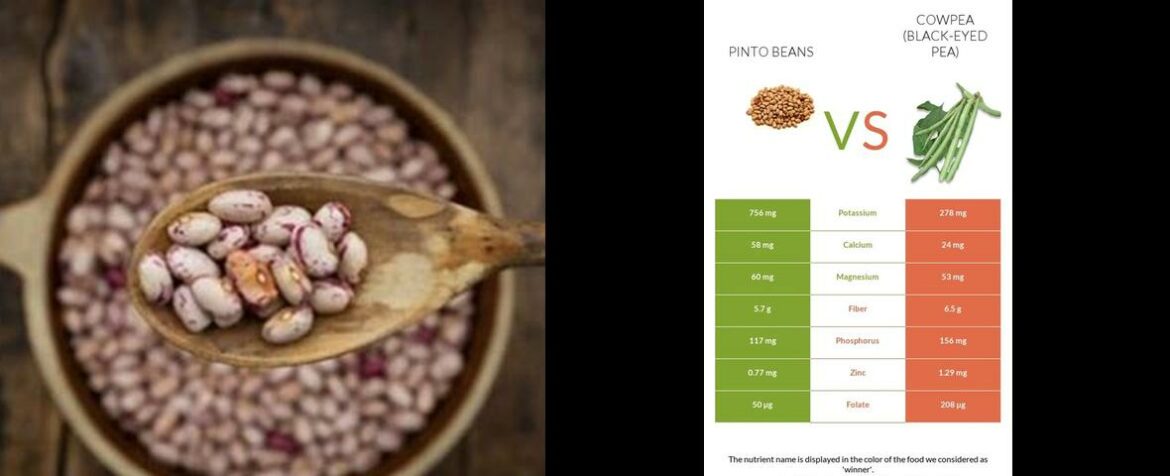Black Eyed Peas Vs Pinto Beans – Get ready to dive into the world of legumes as we unravel the nuances of two nutritious powerhouses: Black Eyed Peas and Pinto Beans. These versatile and delicious legumes have been a staple in cuisines around the world for centuries. Whether you’re a die-hard fan of Black Eyed Peas or a loyal advocate for Pinto Beans, this blog post will answer all your burning questions and help you make an informed choice. So, let’s settle the age-old debate and find out which legume takes the crown in the battle of Black Eyed Peas vs Pinto Beans!
Black Eyed Peas and Pinto Beans: Unraveling the Nuances of Two Nutritious Legumes
In the realm of legumes, black eyed peas and pinto beans stand as two prominent contenders, each boasting a unique nutritional profile and culinary versatility. While often used interchangeably, these beans possess distinct characteristics that set them apart. Delve into this comprehensive exploration of black eyed peas versus pinto beans, uncovering their similarities, differences, and the factors influencing their selection.
Nutritional Powerhouses: Unveiling the Health Benefits
Black eyed peas and pinto beans share the common ground of being nutritional powerhouses, brimming with vitamins, minerals, protein, and fiber. Both legumes provide ample amounts of potassium, a crucial mineral for maintaining healthy blood pressure, and folate, vital for cell growth and development. They also possess a low glycemic index, making them suitable for individuals with diabetes.
Despite these shared attributes, subtle differences exist between the nutritional profiles of these legumes. Black eyed peas hold a slight edge in the protein department, offering approximately 13 grams per cup compared to pinto beans’ 12 grams. Additionally, black eyed peas contain higher levels of vitamin A, essential for vision and immune function. On the other hand, pinto beans boast more iron, a vital component of red blood cells, and folate, crucial during pregnancy for preventing neural tube defects.
Culinary Delights: Exploring the Versatility of Black Eyed Peas and Pinto Beans
Black eyed peas and pinto beans shine in the culinary world, lending their distinct flavors and textures to a vast array of dishes. Black-eyed peas, often associated with Southern U.S. cuisine and African cuisine, impart a creamy texture and slightly nutty flavor to dishes like stews, soups, salads, and main course meals. Pinto beans, originating from Mexico and now cultivated worldwide, are known for their versatility and earthy, slightly mealy taste, making them a staple in Mexican dishes such as chili con carne and refried beans.
Health-Promoting Properties: Unveiling the Functional Benefits
Beyond their nutritional value, black eyed peas and pinto beans possess health-promoting properties that contribute to overall well-being. Both legumes are excellent sources of dietary fiber, essential for maintaining a healthy digestive system and reducing cholesterol levels. They also contain beneficial phytonutrients that help protect against chronic diseases such as cancer, heart disease, and inflammation. Additionally, the complex carbohydrates found in these legumes help regulate blood sugar levels, making them a suitable choice for individuals with diabetes.
Deciding Factors: Selecting the Ideal Legume for Your Needs
The choice between black eyed peas and pinto beans ultimately hinges on personal preference and specific nutritional needs. If protein is a primary concern, black eyed peas may be the preferred choice. However, if iron and folate are of utmost importance, pinto beans emerge as the clear winner. Culinary preferences also play a role; those seeking a creamy texture and nutty flavor may favor black eyed peas, while those desiring a richer, mealy taste may opt for pinto beans.
Conclusion: Embracing the Diversity of Legumes
Black eyed peas and pinto beans, each with its unique nutritional profile and culinary attributes, offer a wealth of health benefits and versatility in the kitchen. Understanding their differences empowers individuals to make informed choices that align with their dietary goals and preferences. Whether incorporated into salads, soups, stews, or main course dishes, these legumes add a nutritious and flavorful touch to any meal.
FAQ about Black Eyed Peas Vs Pinto Beans
Q: What factors should I consider when choosing between black eyed peas and pinto beans?
A: When choosing between black eyed peas and pinto beans, you should consider your personal preference, specific nutritional needs, and culinary preferences.
Q: Which legume is a better source of protein, black eyed peas or pinto beans?
A: Black eyed peas are a better source of protein compared to pinto beans. If protein is a primary concern for you, black eyed peas may be the preferred choice.
Q: Which legume is a better source of iron and folate, black eyed peas or pinto beans?
A: Pinto beans are a better source of iron and folate compared to black eyed peas. If iron and folate are of utmost importance to you, pinto beans emerge as the clear winner.
Q: Do black eyed peas and pinto beans have any nutritional benefits in common?
A: Yes, both black eyed peas and pinto beans are nutritional powerhouses. They are rich in vitamins, minerals, protein, and fiber. They also provide ample amounts of potassium, which is crucial for maintaining healthy blood pressure, and folate, which is vital for cell growth and development.
Q: Are black eyed peas and pinto beans suitable for individuals with diabetes?
A: Yes, both black eyed peas and pinto beans have a low glycemic index, making them suitable for individuals with diabetes.
Q: Are black eyed peas or pinto beans crucial during pregnancy?
A: Both black eyed peas and pinto beans are crucial during pregnancy for preventing neural tube defects. They are excellent sources of folate, which is essential for fetal development.


